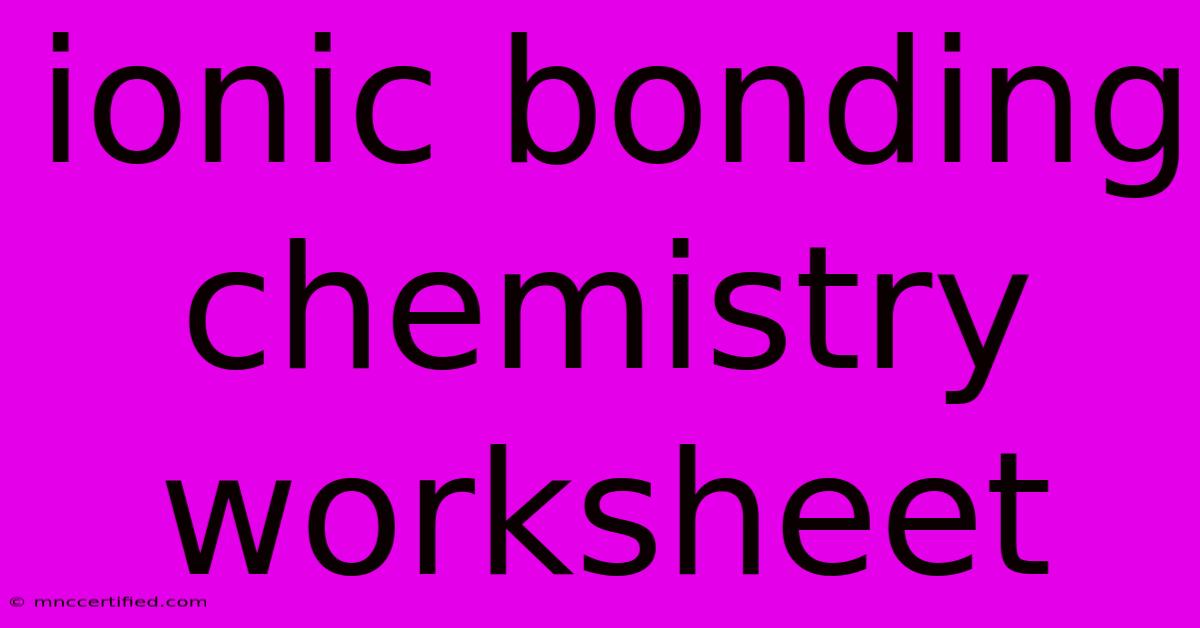Ionic Bonding Chemistry Worksheet

Table of Contents
Ionic Bonding Chemistry Worksheet: A Comprehensive Guide
This article provides a complete guide to understanding and tackling ionic bonding chemistry worksheets. We'll cover the fundamental concepts, offer step-by-step solutions to common problems, and provide resources to further enhance your understanding of ionic bonding. Mastering ionic bonding is crucial for success in chemistry, and this guide will equip you with the tools you need.
Understanding Ionic Bonding
Ionic bonding is a type of chemical bond formed through the electrostatic attraction between oppositely charged ions. These ions are created when one atom donates an electron (or electrons) to another atom. The atom that loses electrons becomes a positively charged cation, while the atom that gains electrons becomes a negatively charged anion. The strong attraction between these oppositely charged ions forms the ionic bond.
Key Concepts to Remember:
- Electronegativity: The ability of an atom to attract electrons towards itself in a chemical bond. Large differences in electronegativity between atoms are characteristic of ionic bonds.
- Valence electrons: Electrons in the outermost shell of an atom, which participate in chemical bonding.
- Octet rule: Atoms tend to gain, lose, or share electrons to achieve a stable electron configuration with eight valence electrons (except for hydrogen and helium, which aim for two).
- Ionic compounds: Compounds formed through ionic bonding, often consisting of a metal and a nonmetal. These compounds are typically crystalline solids with high melting and boiling points.
Types of Problems Found in Ionic Bonding Worksheets
Ionic bonding worksheets typically cover a range of problems designed to test your understanding of the fundamental concepts. These include:
1. Predicting Ionic Compound Formation:
This involves identifying which atoms will form ions and determining the chemical formula of the resulting ionic compound. For example, predicting the formula for the ionic compound formed between sodium (Na) and chlorine (Cl). Sodium readily loses one electron to achieve a stable octet, becoming Na⁺, while chlorine readily gains one electron to become Cl⁻. The resulting compound is NaCl (sodium chloride).
2. Drawing Lewis Dot Structures:
This involves representing the valence electrons of atoms and ions using dots, illustrating electron transfer during ionic bond formation. Accurately drawing Lewis dot structures helps visualize the electron transfer process and the resulting charges on the ions.
3. Naming Ionic Compounds:
This involves using the correct nomenclature to name ionic compounds based on their constituent ions. For instance, NaCl is named sodium chloride, MgO is magnesium oxide, and Al₂O₃ is aluminum oxide. Understanding cation and anion naming conventions is essential.
4. Determining the Charge of Ions:
This requires understanding the periodic table and predicting how many electrons an atom will gain or lose to achieve a stable octet. For example, knowing that Group 1 elements (alkali metals) typically lose one electron to form +1 ions, while Group 17 elements (halogens) typically gain one electron to form -1 ions.
5. Identifying Ionic Compounds from Their Properties:
This tests your understanding of the characteristic properties of ionic compounds, such as high melting and boiling points, brittleness, and the ability to conduct electricity when molten or dissolved in water.
Tips for Solving Ionic Bonding Chemistry Worksheets
- Master the periodic table: Understanding the periodic table is fundamental to predicting ionic charges and compound formation.
- Practice regularly: Consistent practice is key to mastering ionic bonding concepts. Work through numerous examples and problems.
- Use resources: Utilize textbooks, online resources, and videos to clarify any confusion.
- Understand the octet rule: This rule is the cornerstone of ionic bonding.
- Review nomenclature rules: Familiarize yourself with the naming conventions for cations and anions.
Resources for Further Learning
Numerous online resources are available to help you strengthen your understanding of ionic bonding. Search for "ionic bonding tutorials," "ionic bonding practice problems," or "ionic bonding worksheets" on reputable educational websites and platforms. Consider using interactive simulations to visualize the process of ionic bond formation.
By understanding the fundamentals of ionic bonding, practicing regularly, and utilizing available resources, you can confidently tackle any ionic bonding chemistry worksheet. Remember that consistent effort and a clear understanding of the underlying principles are key to success.

Thank you for visiting our website wich cover about Ionic Bonding Chemistry Worksheet. We hope the information provided has been useful to you. Feel free to contact us if you have any questions or need further assistance. See you next time and dont miss to bookmark.
Featured Posts
-
Is Boba Network A Good Investment
Nov 18, 2024
-
Heat N Bond Iron On Adhesive Lite
Nov 18, 2024
-
Bonded Leather Dining Room Chairs
Nov 18, 2024
-
Get To Know Tulisa Contostavlos
Nov 18, 2024
-
Aston Martin James Bond Model Car
Nov 18, 2024